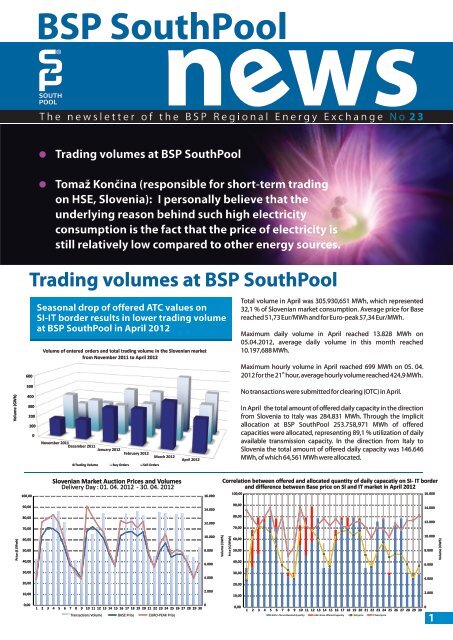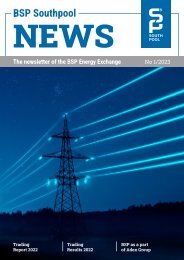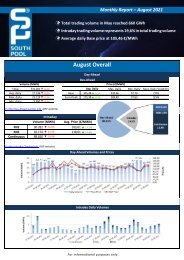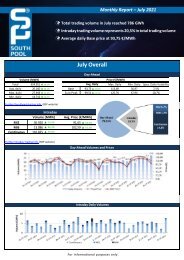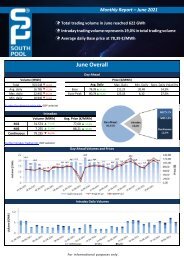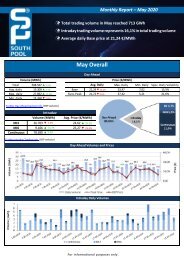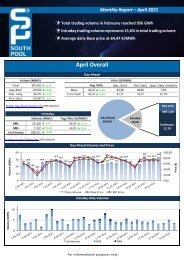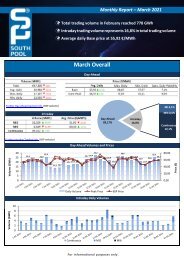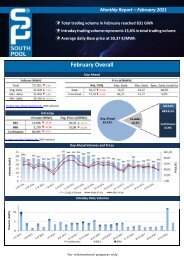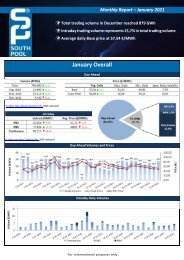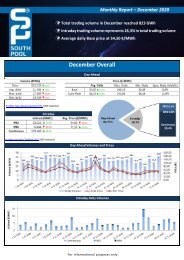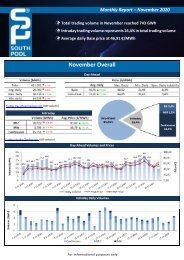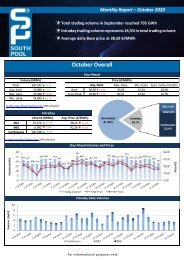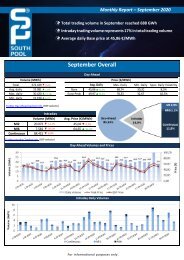BSP SouthPool News May 2012
The newsletter of the BSP Regional Energy Exchange No. 24
The newsletter of the BSP Regional Energy Exchange No. 24
You also want an ePaper? Increase the reach of your titles
YUMPU automatically turns print PDFs into web optimized ePapers that Google loves.
<strong>BSP</strong> <strong>SouthPool</strong><br />
n w<br />
T h e n e w s l e t t e r o f t h e B S P R e g i o n a l E n e r g y E x c h a n g e N o 2 3<br />
Trading volumes at <strong>BSP</strong> <strong>SouthPool</strong><br />
Tomaž Končina (responsible for short-term trading<br />
on HSE, Slovenia): I personally believe that the<br />
underlying reason behind such high electricity<br />
consumption is the fact that the price of electricity is<br />
still relatively low compared to other energy sources.<br />
600<br />
Trading volumes at <strong>BSP</strong> <strong>SouthPool</strong><br />
Seasonal drop of offered ATC values on<br />
SI-IT border results in lower trading volume<br />
at <strong>BSP</strong> <strong>SouthPool</strong> in April <strong>2012</strong><br />
Volume of entered orders and total trading volume in the Slovenian market<br />
from November 2011 to April <strong>2012</strong><br />
Total volume in April was 305.930,651 MWh, which represented<br />
32,1 % of Slovenian market consumption. Average price for Base<br />
reached 51,73 Eur/MWh and for Euro-peak 57,34 Eur/MWh.<br />
Maximum daily volume in April reached 13.828 MWh on<br />
05.04.<strong>2012</strong>, average daily volume in this month reached<br />
10.197,688 MWh.<br />
Maximum hourly volume in April reached 699 MWh on 05. 04.<br />
st<br />
<strong>2012</strong> for the 21 hour, average hourly volume reached 424,9 MWh.<br />
Volume (GWh)<br />
500<br />
400<br />
300<br />
200<br />
100<br />
0<br />
November 2011 December 2011<br />
January <strong>2012</strong><br />
February <strong>2012</strong><br />
March <strong>2012</strong><br />
Trading Volume Buy Orders Sell Orders<br />
April <strong>2012</strong><br />
No transactions were submitted for clearing (OTC) in April.<br />
In April the total amount of offered daily capacity in the direction<br />
from Slovenia to Italy was 284.831 MWh. Through the implicit<br />
allocation at <strong>BSP</strong> <strong>SouthPool</strong> 253.758,971 MWh of offered<br />
capacities were allocated, representing 89,1 % utilization of daily<br />
available transmission capacity. In the direction from Italy to<br />
Slovenia the total amount of offered daily capacity was 146.646<br />
MWh, of which 64,561 MWh were allocated.<br />
100,00<br />
Slovenian Market Auction Prices and Volumes<br />
Delivery Day : 01. 04. <strong>2012</strong> - 30. 04. <strong>2012</strong><br />
16.000<br />
Correlation between offered and allocated quantity of daily capacatiy on SI- IT border<br />
and difference between Base price on SI and IT market in April <strong>2012</strong><br />
100,00<br />
16.000<br />
90,00<br />
14.000<br />
90,00<br />
14.000<br />
80,00<br />
70,00<br />
12.000<br />
80,00<br />
70,00<br />
12.000<br />
Price (€ /Mwh)<br />
60,00<br />
50,00<br />
40,00<br />
10.000<br />
8.000<br />
6.000<br />
Price (€/MWh)<br />
60,00<br />
50,00<br />
40,00<br />
10.000<br />
8.000<br />
6.000<br />
30,00<br />
20,00<br />
4.000<br />
30,00<br />
20,00<br />
4.000<br />
10,00<br />
2.000<br />
10,00<br />
2.000<br />
0,00<br />
1 2 3 4 5 6 7 8 9<br />
0<br />
10 11 12 13 14 15 16 17 18 19 20 21 22 23 24 25 26 27 28 29 30 0,00<br />
0<br />
1 2 3 4 5 6 7 8 9 10 11 12 13 14 15 16 17 18 19 20 21 22 23 24 25 26 27 28 29 30<br />
Transactions Volume BASE Price EURO-PEAK Price<br />
ELES > Terna Allocated Quantity ELSE>Terna Offered Capacatiy SLO price IT Nord price<br />
1
<strong>BSP</strong><br />
n<br />
<strong>SouthPool</strong><br />
w<br />
Tomaž Končina<br />
(responsible for short-term trading<br />
on HSE, Slovenia):<br />
I personally believe that the<br />
underlying reason behind<br />
such high electricity<br />
consumption is the fact that<br />
the price of electricity is still<br />
relatively low compared to<br />
other energy sources.<br />
How much room and how many opportunities are there<br />
in the South-Eastern European region, in particular in the<br />
Western Balkans, for any new players?<br />
The overall picture is different from that in the past, as the<br />
number of traders operating in the SEE region has increased,<br />
and the rules as well as TSO systems have become more<br />
complex. The situation as it is now is rather unfavourable for<br />
anyone, but above all for small enterprises, as the latter find it<br />
difficult to manage the risks associated with the respective<br />
market. This assumption is confirmed by the fact that certain<br />
large foreign enterprises initially enter a new market by means<br />
of investments rather than trading. The fact is that the South-<br />
Eastern European region is relatively closed and in a situation<br />
when energy or transmission capacity prices skyrocket, the<br />
fulfilment of contractual obligations is questionable. It is for this<br />
reason that the situation of partner companies is reviewed<br />
increasingly more thoroughly. When closing a deal, one needs to<br />
resort to guarantees, which serve as insurance against nonpayment<br />
or failure to deliver energy. Larger companies deal with<br />
such shocks or risks much easier than small enterprises. HSE has<br />
no problems in this respect, owing to its size and reputation.<br />
Does this mean that many of the small enterprises have<br />
withdrawn from the market?<br />
Some of them did withdraw one way or another, but in general,<br />
there is a certain caution as regards doing business.<br />
What is the current situation on the market, or the<br />
trading, that is, in light of the dry season we are<br />
experiencing?<br />
When hydrological conditions in the region are good, there may<br />
be a surplus of energy, which depends on the consumption. This<br />
energy can be sold on foreign markets. Recently, the<br />
hydrological situation has not been favourable owing to a<br />
persistent dry season, so there are no surpluses. The<br />
consumption is currently moderate or even high if we consider<br />
the crisis, while transmission capacities reductions as well as<br />
repairs of certain production units have both been affecting the<br />
whole situation. I personally believe that the underlying reason<br />
behind such high electricity consumption is the fact that the<br />
price of electricity is still relatively low compared to other energy<br />
sources. For that reason, increasingly more consumers tend to<br />
use electric heating and cooling systems.<br />
What do you think will happen after 1 January 2013 when<br />
the Serbian market which is the most important market<br />
in the SEE region will open and electricity will no longer<br />
be treated as a social good?<br />
I believe that certain cuts which have been announced by the<br />
politicians would not be implemented that rigorously. It is hard<br />
to deprive people of a good that enables normal life, as this<br />
might result in general dissatisfaction. I think that in certain<br />
countries within the region the social note is displayed<br />
particularly with regard to electricity.<br />
Yet the region in general – notwithstanding all the issues<br />
mentioned – holds potential for electricity traders.<br />
Definitely. And in poor hydrologic conditions, there are always<br />
other options which go to show one's ability to make a longterm<br />
assessment of market developments. And certainly there<br />
are growth opportunities!<br />
How did the cold snap earlier this February affect the<br />
regional and the wider European electricity market?<br />
Some countries even closed their borders.<br />
Yes, this is true. Two things coincided: extremely poor hydrologic<br />
conditions and severe winter weather. Power generation<br />
systems were so much overloaded that the reserves were used<br />
practically all the way. The reliability of energy supply in the<br />
region was seriously compromised, hence some countries<br />
decided to temporarily close their borders. To be more specific,<br />
TSO took back some of the annual or monthly capacities which a<br />
certain trader had previously purchased from TSO and used<br />
them for the export of energy for the purpose of its own electric<br />
power system. This reaction by TSO put in an unenviable<br />
position all those traders who used the above mentioned<br />
countries for energy transit. In turn, they had to use alternative<br />
transmission routes to be able to supply their partners with<br />
energy. The decision whether this has been justified or not lies<br />
with the legal experts. Luckily, HSE has had no problems in this<br />
regard, as we have managed to fulfill all our obligations towards<br />
our partners despite the reductions.<br />
Let us move to the Serbian electricity market which is the<br />
most interesting market in the region. What are the<br />
expectations regarding this particular market which<br />
borders eight countries, and which has been increasingly<br />
modernising and upgrading its combined heat and<br />
power production capacities, and has been forming also<br />
its own electricity exchange?<br />
Well, this market or this country, that is, is currently in a transition<br />
similar to the one Slovenia has already undergone. This means<br />
that the market will need to ensure, just as other markets have<br />
had to, a certain transparency as well as other operating<br />
conditions, which is primarily the function of institutions that<br />
influence the electric power market in the country. Recently, the<br />
regional exchange <strong>BSP</strong> Southpool started its operations in<br />
Serbia, so we might say that auction trading is already possible<br />
at the Serbian exchange. The problem as I see it is the liquidity<br />
that urgently needs to be improved by means of involving a<br />
market promoter. But it is also true that Serbia has been<br />
developing its own electricity exchange, which has been<br />
discussed for quite a long time now. We will see when it will really<br />
come to life. I think it might be a good idea for <strong>BSP</strong> Southpool<br />
and the exchange concerned to consider the possibility of<br />
cooperation and thus make use of a variety of synergies such<br />
partnership has to offer. The establishment of a liquid exchange<br />
would take Serbia's energy trading to the next level and bring<br />
Serbia closer to the group of countries it gravitates towards.<br />
To read the full interview with mr. Tomaž Končina<br />
please visit the web page: www.energetika.net.<br />
2
<strong>BSP</strong><br />
n<br />
<strong>SouthPool</strong><br />
w<br />
Cooperation between<br />
<strong>BSP</strong> <strong>SouthPool</strong> and<br />
Energetika.NET<br />
The <strong>BSP</strong> newsletter published interviews with our<br />
participants about views of development of Slovenia<br />
electricity market and power exchange. As an<br />
upgrade to these interviews, we will cooperate with<br />
energetika.NET, which is one of the most important<br />
Slovenian provider of energy news and the foremost<br />
web source of energy information from South Eastern<br />
Europe. Together we will try to find topics and person<br />
that will ensure our readers with addition content. In<br />
the <strong>BSP</strong> newsletter, part of the interview will be<br />
published and the whole interview will be available<br />
on the website www.energetika.net.<br />
Training Course<br />
th<br />
On the 8 of <strong>May</strong> <strong>BSP</strong> organized Exchange<br />
trader training course. On the training<br />
attended four participants from<br />
Slovenian company GEN energija.<br />
Participants got knowledge about <strong>BSP</strong><br />
power exchange rules, clearing and<br />
trading platform.<br />
Next Exchange trader training course will<br />
st<br />
take place of 31 of <strong>May</strong> <strong>2012</strong>. All<br />
information about training are available<br />
on our web page.<br />
The newsletter is published<br />
by <strong>BSP</strong> Regional Energy Exchange LLC.<br />
Editor in Chief<br />
Gorazd Ažman<br />
Completed in <strong>May</strong> <strong>2012</strong>, No 23/<strong>2012</strong><br />
Address: <strong>BSP</strong> Regional Energy Exchange LLC,<br />
Dunajska 156, SI-1000 Ljubljana, Slovenia<br />
Telephone number: + 386 1 620 76 76<br />
Fax number: + 386 1 620 76 77<br />
Website: www.bsp-southpool.com<br />
E-mail: info@bsp-southpool.com<br />
Copyright © 2008 – <strong>BSP</strong> d.o.o. - All rights reserved<br />
<strong>BSP</strong> Regional Energy Exchange<br />
Your energy choice.<br />
3


